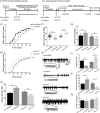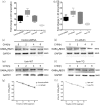Transgenic overexpression of furin increases epileptic susceptibility
- PMID: 30333479
- PMCID: PMC6193048
- DOI: 10.1038/s41419-018-1076-x
Transgenic overexpression of furin increases epileptic susceptibility
Abstract
The proprotein convertase Furin plays crucial roles in the pathology of many diseases. However, the specific role of furin in epilepsy remains unclear. In our study, furin protein was increased in the temporal neocortex of epileptic patients and in the hippocampus and cortex of epileptic mice. The furin transgenic (TG) mice showed increased susceptibility to epilepsy and heightened epileptic activity compared with wild-type (WT) mice. Conversely, lentivirus-mediated knockdown of furin restrained epileptic activity. Using whole-cell patch clamp, furin knockdown and overexpression influenced neuronal inhibitory by regulating postsynaptic gamma-aminobutyric acid A receptor (GABAAR)-mediated synaptic transmission. Importantly, furin influenced the expression of GABAAR β2/3 membrane and total protein in epileptic mice by changing transcription level of GABAAR β2/3, not the protein degradation. These results reveal that furin may regulate GABAAR-mediated inhibitory synaptic transmission by altering the transcription of GABAAR β2/3 subunits in epilepsy; this finding could provide new insight into epilepsy prevention and treatment.
Conflict of interest statement
The authors declare that they have no conflict of interest.
Figures








Similar articles
-
Inhibitory synapse deficits caused by familial α1 GABAA receptor mutations in epilepsy.Neurobiol Dis. 2017 Dec;108:213-224. doi: 10.1016/j.nbd.2017.08.020. Epub 2017 Sep 1. Neurobiol Dis. 2017. PMID: 28870844
-
CNTNAP4 Impacts Epilepsy Through GABAA Receptors Regulation: Evidence From Temporal Lobe Epilepsy Patients and Mouse Models.Cereb Cortex. 2018 Oct 1;28(10):3491-3504. doi: 10.1093/cercor/bhx215. Cereb Cortex. 2018. PMID: 28968899
-
Protrudin modulates seizure activity through GABAA receptor regulation.Cell Death Dis. 2019 Nov 27;10(12):897. doi: 10.1038/s41419-019-2118-8. Cell Death Dis. 2019. PMID: 31772151 Free PMC article.
-
GABAA receptor heterogeneity, function, and implications for epilepsy.Neurology. 2007 Feb 20;68(8):612-4. doi: 10.1212/01.wnl.0000255669.83468.dd. Neurology. 2007. PMID: 17310035 Review. No abstract available.
-
Cellular abnormalities and synaptic plasticity in seizure disorders of the immature nervous system.Ment Retard Dev Disabil Res Rev. 2000;6(4):258-67. doi: 10.1002/1098-2779(2000)6:4<258::AID-MRDD5>3.0.CO;2-H. Ment Retard Dev Disabil Res Rev. 2000. PMID: 11107191 Review.
Cited by
-
Development and Prospects of Furin Inhibitors for Therapeutic Applications.Int J Mol Sci. 2024 Aug 24;25(17):9199. doi: 10.3390/ijms25179199. Int J Mol Sci. 2024. PMID: 39273149 Free PMC article. Review.
-
Impact of SARS-CoV-2 on Host Factors Involved in Mental Disorders.Front Microbiol. 2022 Apr 4;13:845559. doi: 10.3389/fmicb.2022.845559. eCollection 2022. Front Microbiol. 2022. PMID: 35444632 Free PMC article. Review.
-
GLS2 reduces the occurrence of epilepsy by affecting mitophagy function in mouse hippocampal neurons.CNS Neurosci Ther. 2024 Oct;30(10):e70036. doi: 10.1111/cns.70036. CNS Neurosci Ther. 2024. PMID: 39404053 Free PMC article.
-
Cerebral furin deficiency causes hydrocephalus in mice.Genes Dis. 2023 Jul 8;11(3):101009. doi: 10.1016/j.gendis.2023.04.037. eCollection 2024 May. Genes Dis. 2023. PMID: 38292192 Free PMC article.
-
Pan-Cancer Analysis of FURIN as a Potential Prognostic and Immunological Biomarker.Front Mol Biosci. 2021 Apr 22;8:648402. doi: 10.3389/fmolb.2021.648402. eCollection 2021. Front Mol Biosci. 2021. PMID: 33968987 Free PMC article.
References
Publication types
MeSH terms
Substances
LinkOut - more resources
Full Text Sources
Medical
Molecular Biology Databases
Miscellaneous

